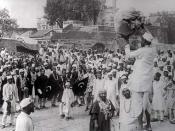Not so long ago, communication struggled to define itself as a separate academic discipline with a future. Representative of this time was the special issue of the Journal of Communication entitled, "Ferment in the Field," in which scholars such as Wilbur Schramm, Everett Rogers, Steven Chaffee, Gerald Miller, George Gerbner and others debated the future of the field. Although aspects of communication study had been around for decades, the volume represented a milestone in the birth of communication as a separate discipline. As the Editors noted, the volume was "the first time that so many internationally prominent scholars have examined and commented upon communications as a field of study in one publication". In their words, the growth and rapid development of communication as a discipline was "coming of age." No longer would communication scholars be content to be just another research area of psychology, sociology or anthropology. Once the discipline communication achieved the equivalent of academic autonomy, it began proliferating into multiple specializations.
(Broome, B. J. 1996)The nature of cultures today is changed and so is the cultural exchange. Cultures also cross national boundaries which dictate that inter cultural communication has wide range of interests for each others. People around one part of the world now know a variety of English words and have contact with American cultural exports such as brand-name clothing and technological products, films and music, and mass-produced foods. Many anthropologists have become interested in how dominant societies can shape the culture of less powerful societies, a process some researchers call cultural hegemony. Today, many anthropologists openly oppose efforts by dominant world powers, such as the U.S. government and large corporations, to make unique smaller societies adopt Western commercial culture. Muslims are a more urban community than Hindus. Muslims were 17 percent of India's urban population...


